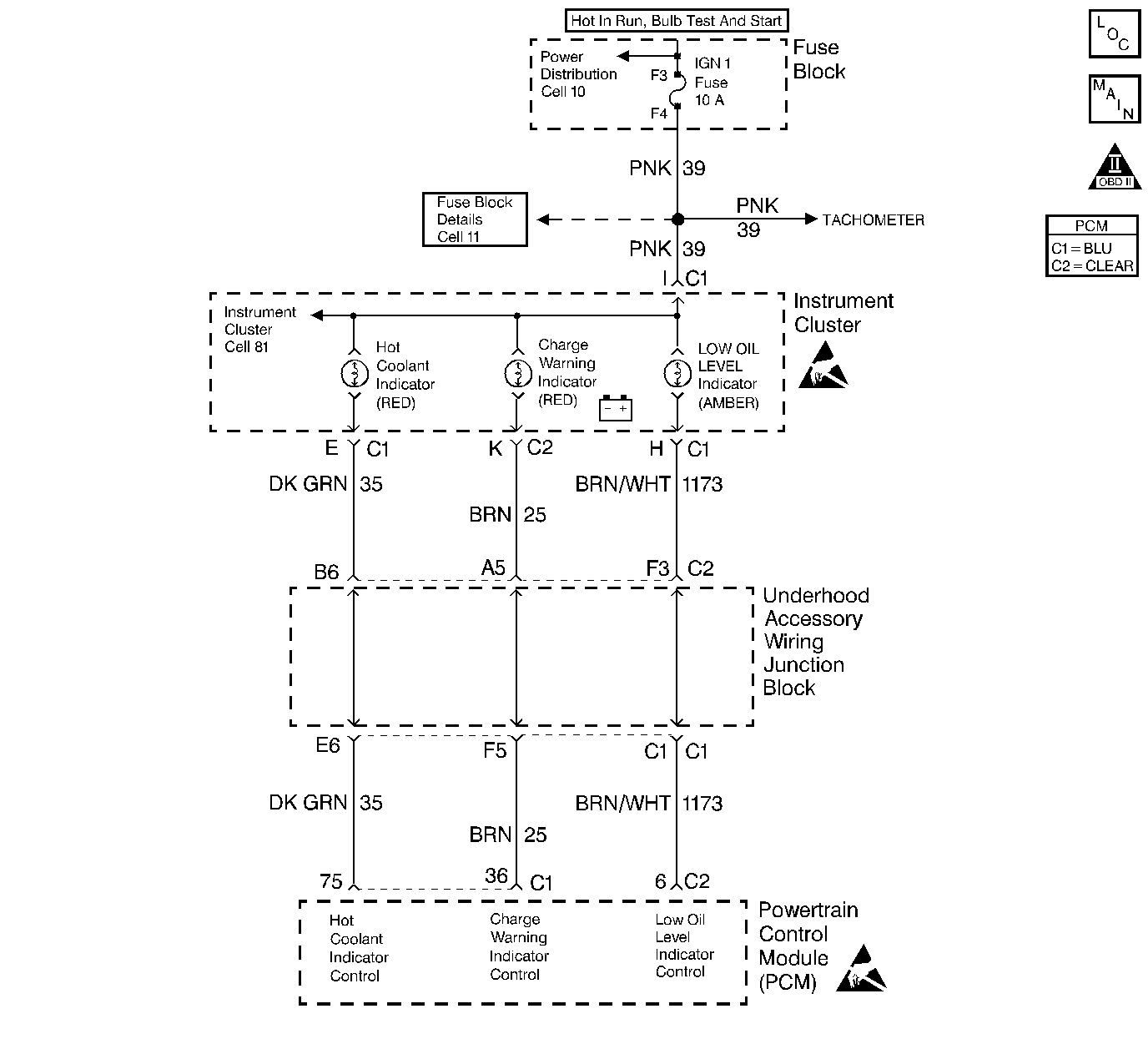
Circuit Description
The PCM controlled lamps are powered through the IGN 1 fuse. The PCM turns ON the bulb, LED, or driver info center indicator by supplying a path to ground through the PCM.
Diagnostic Aids
A PCM controlled lamp ON at all times most likely indicates that a condition is present which requires the attention of the vehicle operator. Conditions which will illuminate each lamp are as follows:
| • | CHARGE WARNING Lamp will be illuminated under any of the following conditions: |
| - | When the engine speed is greater than 1200 RPM and system voltage falls below 10 volts for longer than 10 seconds. The PCM commands the generator lamp OFF when system voltage rises to above 12 volts. |
| - | When the generator control circuit (L terminal) remains low for longer than 10 seconds. |
| • | LOW OIL LEVEL Lamp When the ignition is first turned ON, the PCM commands the Low Oil Level lamp ON for a brief period of time (approximately 3 seconds) to test the bulb. If the engine oil level switch indicates that a low oil level condition exists, the PCM commands the Low Oil Level Lamp ON. The PCM will test for low oil level at key ON if either of the following conditions exist: |
| - | If the engine coolant temperature is below 15°C (59°F), the PCM checks the state of the engine oil level switch at start up. |
| - | If the engine coolant temperature is between 15°C (59°F) and 140°C (284°F), the difference between engine coolant temperature at last key OFF and the engine coolant temperature at the current key is must be at least 12°C (54°F). |
| • | HOT COOLANT Lamp When the ignition is first turned ON, the PCM commands the Hot Coolant lamp ON for a brief period of time (approximately 3 seconds) to test the bulb. If the Engine Coolant Temperature sensor indicates that a hot coolant condition exists, the PCM commands the Hot Coolant Lamp ON. |
For diagnosis of the instrument panel, perform the System Check in the Instrument Cluster section of Electrical Diagnosis.
Check for the following conditions:
| • | Poor connection at PCM. Inspect harness connectors for backed out terminals, improper mating, broken locks, improperly formed or damaged terminals, and poor terminal to wire connection. |
| • | Damaged harness. Inspect the wiring harness for damage. If the harness appears to be OK, disconnect the PCM and turn the ignition ON. Observe a voltmeter connected to the affected PCM output circuit while moving connectors and wiring harnesses related to the PCM output circuit. A change in voltage will indicate the location of the fault. |
| • | Engine oil level switch circuit: If the problem was with the Low Oil Level lamp and PCM Controlled Warning Lamps did not isolate a problem, use Engine Oil Level Switch Diagnosis. |
Test Description
The number(s) below refer to the step number(s) on the Diagnostic Table:
-
Normally, ignition feed voltage should be present on the output driver circuit with the PCM disconnected and the ignition turned ON.
-
Checks for a shorted component or a short to battery positive voltage on the output driver circuit. Either condition would result in a measured current of over 1.5 amps. Also checks for a component that is going open while being operated, resulting in a measured current of 0 amps.
-
Checks for a faulty instrument cluster.
-
This vehicle is equipped with a PCM which utilizes an Electrically Erasable Programmable Read Only Memory (EEPROM). When the PCM is being replaced, the new PCM must be programmed. Refer to Powertrain Control Module Replacement/Programming .
Step | Action | Value(s) | Yes | No |
|---|---|---|---|---|
1 | Was the Powertrain OBD System Check performed? | -- | ||
2 | Was the instrument cluster system check in Electrical Diagnosis performed? | -- | Go to Electrical Diagnosis | |
Is voltage near the specified value? | B+ | |||
Does the current reading remain between the specified values? | 0.05 Amp 1.5 Amps | |||
Is the voltage at the specified value? | 0.0V | |||
6 | Locate and repair short to voltage in affected PCM output circuit. Refer to Wiring Repairs in Wiring Systems. Is the action complete? | -- | -- | |
7 | Check the ignition feed fuse for the instrument panel cluster indicator lamps. Is the fuse blown? | -- | ||
8 |
Is the action complete? | -- | -- | |
9 |
Is the voltage near the specified value? | B+ | ||
10 |
Was a problem found? | -- | ||
11 |
Was a problem found? | -- | ||
12 |
Does the test light flash ON and OFF? | -- | Go to Diagnostic Aids | |
13 |
Was a problem found? | -- | ||
14 | Locate and repair open in ignition feed circuit to the instrument panel cluster indicator lamps. Refer to Wiring Repairs in Wiring Systems. Is the action complete? | -- | -- | |
15 | Replace the instrument panel cluster. Is the action complete? | -- | -- | |
|
Important: : Replacement PCM must be programmed. Refer to Powertrain Control Module Replacement/Programming . Replace the PCM. Is the action complete? | -- | -- | ||
17 | Operate the affected lamp using the scan tool output tests function. Does the affected lamp operate properly? | -- | System OK |
